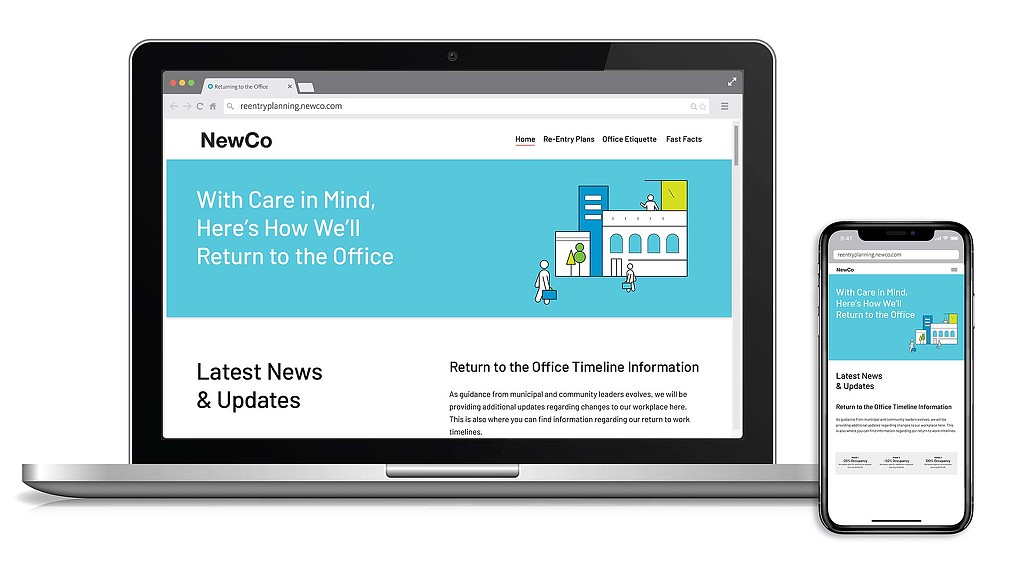Digital Communications Tips for Workplace Reentry
September 24, 2020 | By Michael Chappell, Jillian Allerton, Molly Murphy
Editor’s Note: This post is part of our ongoing exploration of how design is responding to the COVID-19 pandemic.
Only one in eight of Gensler’s U.S. Work from Home Survey respondents say they would like to work from home full-time after the pandemic is over. Most want to spend much of their normal workweek at the office, while maintaining the ability to work from home for part of the week. While employees want to return to the office, there are a few uncertainties around reentry planning and how to communicate those plans out to employees. Given the highly distributed nature of remote work, a digital communications plan is key to a successful return to the office strategy.
As organizations are navigating the complex challenges of returning to the office, many are taking a cautious, thoughtful approach to protect their employees’ well-being. They’re asking: How do we help our people return to the office? How do we communicate consistently to multiple audiences? How do we talk about the changes we’re making to the work environment? With all these uncertainties, employees need to feel comfortable about the measures being taken.
When it comes to health and safety in the workplace, employees want to receive information they can trust. According to the 2020 Edelman Trust Barometer, employer communications is the most credible source of information about the coronavirus. The survey showed that “my employer” was the most trusted institution by 18 points over business in general and NGOs, by 27 points over government and media.
As you reoccupy the office, success will be influenced by your staff and their ability to adjust to new habits, behaviors, and expectations. For a successful reentry plan, it will be important to share the changes that workers can expect in the office — from new cleaning procedures to seat assignments that support social distancing.
The following are four best practices for digital communications when preparing employees for their reentry to the workplace:
Tips for Digitally Communicating Reentry Planning
1. Centralize reentry information for easy navigation.Bring workplace reentry information, such as phasing plans, new protocols, and key resources, together in one centralized, easy to access digital portal.
Direct employees to comprehensive information on a website when leveraging multiple reentry communication tools, such as environmental signage, emails, and virtual presentations. Integrate QR codes into environmental signage and reentry training presentations so that employees have quick access to additional policy and protocol information from mobile devices.
2. Provide consistent messaging across audiences.Digitally centralizing reentry plans is particularly important at this time, given the distributed nature of employees working from home. Provide consistent reentry messages to all staff regardless of their work location, especially as groups of employees are phased back to the office and others remain at home.
Set up multiple user profiles on a reentry planning website to allow degrees of information access based on target audience. Share a select portion of reentry protocols and messaging with outside guests and visitors, while extending full access to internal teams. This allows you to provide consistent messages to various audiences without having to create multiple communications or support several communication platforms. While the office may only be ready to host employees at this time, the user administration features of a website allow you to plan for the eventual return of guests and visitors over the long term.
3. Evolve reentry plans as new information becomes available.Research, data, and government recommendations are continuously changing as more information is understood about COVID-19 and its implications for workplace reentry planning. Leverage digital communications to quickly update content and disseminate information to the appropriate audiences. While analog communications may require reprinting and redistribution, the dynamic nature of a website ensures that information can be refreshed in real-time.
4. Communicate in a friendly and approachable manner.While reentry communications are important, they shouldn’t feel harsh or unwelcoming. Shift the design and tone of voice to something more friendly and human so employees feel welcome when planning their return. Using “we” and “our” reinforces the message that we are all in this together and that it will take our collective action to come back to the office successfully.
We believe every organization should have effective communication tools to support the return to the office during these uncertain times, and we want to help. Please contact us to begin a conversation about how digital communications – like a microsite — can support you now and into the future.
For media inquiries, email .


